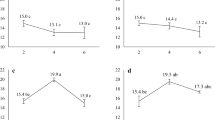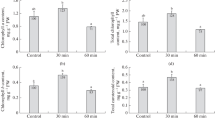Abstract
Antioxidant activity of extracts of barley leaves cultivated by light emitting diode (LED) radiation such as red, far-red, blue, blue-red, green, yellow, and white light was investigated. After measuring length and weight of the leaves cultivated, barley leaves were extracted using 70% ethanol. The Hunter color value, total phenolic compounds, and 1,1-diphenyl-2-picrylhydrazyl (DPPH) and 2,2′-azinobis (3-ethylbenzothiazoline-6-sulfonic acid) diammonium salts (ABTS) radical-scavenging activities of extracts were determined. Lengths of samples cultivated by red and green light radiation were 13.7 and 13.6 cm, respectively. Hunter L* values of samples cultivated by red, far-red, and UVA radiation were 65.29, 67.55, and 67.57, respectively. The content of total phenolic compounds of samples cultivated by blue light radiation was 1.62 mg/L of sample. The DPPH radical-scavenging activities of samples cultivated by blue, green, UVA, and white light radiation were 64.28, 48.92, 55.95, and 48.72%, respectively. The ABTS radical-scavenging activity of samples cultivated by blue light radiation scored higher compared with those of samples cultivated with other LED lights. Antioxidant activities of barley leaves showed different results depending on harvest time. Application of LED radiation during re-cultivation after the first harvest showed increasing tendency on antioxidant activity of barley leaves.
Similar content being viewed by others
References
Blois MS (1958) Antioxidant determination by the use of a stable free radical. Nature 181, 1190–1200.
Giliberto L, Perrotta G, Pallara P, Weller JL, Fraser PD, Bramley PM, Fiore A, Tavazza M, and Giuliano G (2005) Manipulation of the blue light photoreceptor crytochrome 2 in tomato affects vegetative development, flowering time, and fruit antioxidant content. Plant Physiol 137, 199–208.
Halliwell B (1997) Antioxidnats: The basics-what they are and how to evaluate them. Adv Pharmacol 38, 3–20.
Halliwell B and Gutteridge JMC (2007) In Free Radicals in Biology and Medicine, (4th ed.), Clarendon, Oxford, UK.
Kataoka I, Sugiyama A, and Beppu K (2003) Role of ultraviolet radiation in accumulation of anthocyanin in berries of Gros Colman grapes (Vitis vinifera L.). J Japan Soc Hort Sci 72, 1–6.
Kim SJ, Hahn EJ, Heo JW, and Paek KY (2004) Effects of LEDs on net photosynthetic rate, growth and leaf stomata of chrysanthemum plantlets in vitro. Sci Hortic-Amsterdam 101, 143–151.
Kopsell DA and Kopsell DE (2008) Genetic and environmental factors affecting plant lutein/zeaxanthin. Agro Food Ind Hi-Tech 19, 44–46.
Qian L and Kubota C (2009) Effects of supplemental light quality on growth and phytochemicals of baby leaf lettuce. Environ Exp Bot 67, 59–64.
Lee SC, Kim JH, Jeong SM, Kim DR, Ha JU, Nam KC, and Ahn DU (2003) Effect of far-infrared radiation on the antioxidant activity of rice hulls. J Agric Food Chem 51, 4400–4403.
Lee NY, Kim YK, Choi ID, Cho SK, Hyun JN, Choi JS, Park KH, Kim KJ, and Lee MJ (2010) Biological activity of barley (Hordeum vulgare L.) and barley by-product extracts. Food Sci Biotechnol 19, 795–791.
Luthria D, Mukhopadhyay S, and Krizek DT (2006) Content of total phenolics and phenolic acids in tomato (Lycopersicon esculentum Mill) fruits as influenced by cultivar and solar UV radiation. J Food Compos Anal 19, 771–777.
Miyashita Y, Kitaya Y, Kozai Y, and Kimura T (1995) Effect of red and far-red light on the growth and morphology of potato plantlets in vitro: using light emitting diode as a light source for micropropagation. Acta Hortic 393, 189–194.
Nam KC, Kim JH, Ahn DU, and Lee SC (2004) Far-infrared radiation increases the antioxidant properties of rice hull extract in cooked turkey meat. J Agric Food Chem 52, 374–379.
Niki E (2010) Assessment of antioxidant capacity in vitro and in vivo. Free Radical Bio Med 49, 503–515.
Nishlyama T, Haglwara Y, Haglwara H, and Shlbamoto T (1992) Inhibitory effect of 2-O-Glycosyl isovitexin and átocopherol on genotoxic glyoxal formation in a lipid peroxidation system. Food Chem Toxicol 32, 1047–1051.
Oliveira AP, Pereira JA, Andrade PB, Valentão P, Seabra RM, and Silva BM (2007) Phenolic profile of Cydonia oblonga miller leaves. J Agric Food Chem 55, 7926–7930.
Osawa T, Katsuzaki H, Hagiwara Y, Hagiwara H, and Shibamoto T (1992) A novel antioxidant isolated from young green barely leaves. J Agric Food Chem 40, 1135–1138.
Park SJ, Joung YM, Choi MK, Kim YK, Kim JG, Kim KH, and Kang MW (2008) Chemical properties of barley leaf using different drying methods. J Korean Soc Food Sci Nutr 37, 60–65.
Papas AM (1999) In Antioxidnat Status, Diet, Nutrition, and Health. CRC Press, Boca Laton, Florida, USA.
Pérez-Balibrea S, Moreno DA, and García-Viguera C (2008) Influence of light on health-promoting phytochemicals of broccoli sprouts. J Sci Food Agr 88, 904–910.
Reena R and Kalidas S (2005) Developmental stimulation of total phenolics and related antioxidant activity in light- and dark-germinated corn by natural elicitors. Precess Biochem 40, 1721–1732.
Senger H (1982) The blue light on plants and microorganisms. Photochem Photobiol 35, 911–920.
Shen C, Yang Y, Jin S, Ming J, Feng H, and Xu Z (2010) White light-emitting diodes using blue and yellow-orange-emitting phosphors. Optik-International Journal for Light and Electron Optics 121, 1487–1491.
Tsormpatsidis E, Henbest RGC, Davis FJ, Battey NH, Hadley P, and Wagstaffe A (2008) UV irradiance as a major influence on growth, development and secondary products of commercial importance in Lollo Rosso Lettuce Revolution grown under polyethylene film. Environ Exp Bot 63, 232–239.
Vergeer LHT, Aarts TL, and de Groot JD (1995) The wasting disease and the effect of abiotic factors (light intensity, temperature, salinity) and infection with Labyrinthula zosterae on the phenolic content of Zostera marina shoots. Aquat Bot 52, 35–44.
Wu MC, Hou CY, Jiang CM, Wang YT, Wang CY, Chen HH, and Chang HM (2007) A novel approach of LED light radiation improves the antioxidant activity of pea seedlings. Food Chem 101, 1753–1758.
Yu L, Haley S, Perret J, and Harris M (2004) Comparison of wheat flours grown at different locations for their antioxidant properties. Food Chem 86, 11–16.
Zhao H, Dong J, Lu J, Chin J, Li Y, Shan L, Lin Y, Fan W, and Gu G (2006) Effects of extraction solvent mixtures on antioxidant activity evaluation and their extraction capacity and selectivity for free phenolic compounds in barley (Hordeum vulgare L.). J Agric Food Chem 54, 7277–7286.
Zhou Y and Singh BR (2004) Effect of light on anthocyanin levels in submerged, harvested Cranberry fruit. J Biomed Bbiotechnol 5, 259–263.
Author information
Authors and Affiliations
Corresponding author
Rights and permissions
About this article
Cite this article
Lee, N.Y., Lee, MJ., Kim, YK. et al. Effect of light emitting diode radiation on antioxidant activity of barley leaf. J. Korean Soc. Appl. Biol. Chem. 53, 685–690 (2010). https://doi.org/10.3839/jksabc.2010.104
Received:
Accepted:
Issue Date:
DOI: https://doi.org/10.3839/jksabc.2010.104




